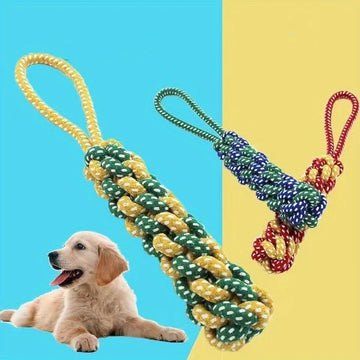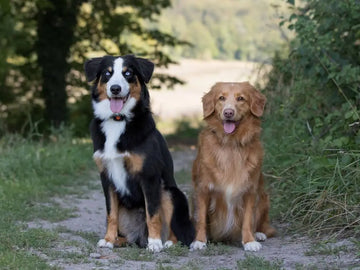Fetching is one of the most rewarding games for dogs and their owners, yet not all dogs take to it naturally. If your dog doesn't fetch a toy, you may be left scratching your head, wondering what went wrong. However, this behavior isn’t uncommon, and it can stem from a variety of factors, ranging from personality to past experiences. Addressing this issue takes understanding, patience, and a little creativity.
Whether it’s a squeaky ball or puppy fetch toys, the game of fetch can provide much-needed physical exercise and mental stimulation for your furry friend. But if they’re not engaging, it’s time to dig deeper into the possible reasons and solutions.

Reasons Why Your Dog Doesn't Fetch the Toy
Lack of Natural Instinct
Some dogs don’t see fetching as an instinctive behavior. Breeds like retrievers often excel at this activity because of their history as working dogs trained to retrieve game. In contrast, breeds like pugs or mastiffs might not have the same natural inclination toward chasing or retrieving.
Fear or Negative Experiences
If your dog had a negative interaction with pet toys, such as being startled by a loud squeak, they may associate toys with fear or discomfort. This emotional response can make them avoid the toy altogether.
Lack of Early Training
Puppies exposed to toys like puppy plush toys during their developmental phase often grow up understanding that toys are sources of fun and engagement. Dogs that miss out on this exposure may need more guidance to spark their interest in fetching.
Physical Challenges
Fetching might seem like a simple activity, but physical discomfort can play a big role in your dog's reluctance. Joint pain, dental issues, or even fatigue can make chasing a ball or grabbing a toy unpleasant.
Disinterest in the Toy Itself
Sometimes, the problem lies with the toy. Dogs can be picky about their playthings. If your dog doesn’t show interest in the toy you’re offering, consider trying something new, like plush dog toys designed to be soft and comforting. Switching to a toy that suits their preferences can make all the difference.

How to Train Your Dog to Fetch
Start with the Right Toy
Selecting the right toy is crucial for teaching your dog to fetch. While balls are a classic option, some dogs prefer the texture and feel of puppy plush toys, especially if they’re soft and easy to carry. For teething puppies, softer toys can provide comfort while encouraging engagement.
Create Positive Associations
Introduce the toy to your dog in a way that builds excitement. For example, wave it around, squeak it if it has a sound mechanism, or even rub a treat on it to capture their attention. Positive reinforcement, such as praise or treats, will help them see the toy as something enjoyable.
Break Down the Fetch Process
Training a dog to fetch is often about breaking the game into smaller, manageable steps:
- First, encourage them to chase after the toy.
- Next, reward them for picking it up, even if they don’t bring it back immediately.
- Finally, teach them to return it by using commands like “bring it here” and rewarding them when they do.
Motivate with Treats
Many dogs respond well to food rewards during training. Use treats as a motivator for each step of the process, especially when they pick up the toy or bring it back. Over time, transition to verbal praise or playtime rewards.
Use a Variety of Toys
If one type of toy doesn’t work, experiment with others. Dogs often have unique preferences, so try a mix of balls, squeaky toys, or puppy fetch toys. The variety can spark their interest and keep them engaged during training.
Alternatives to Fetch for Non-Fetching Dogs
If your dog still doesn’t engage with fetch despite your efforts, don’t worry—there are many other ways to bond and provide exercise.
Tug-of-War
Tug games with sturdy, durable toys can give your dog a satisfying physical and mental workout. Look for a toy that’s easy for them to grip, ensuring it’s safe and fun.
Hide-and-Seek with Toys
Hide a toy, such as plush dog toys, around the house and encourage your dog to find it. This activity stimulates their mind and provides an alternative form of play.
Puzzle Games
Interactive puzzle toys that dispense treats are excellent for keeping your dog mentally engaged. They can also serve as a great option for dogs who don’t enjoy active chasing games.
Tips to Keep Fetch Fun and Engaging
Keep Sessions Short and Sweet
Avoid overloading your dog by keeping fetch sessions short but frequent. Ten-minute sessions a few times a day are often more effective than one long session.
Switch Up the Toys
Introduce new toys periodically to maintain their excitement. A fresh pet toy can reignite your dog’s interest in fetching and keep the game enjoyable for both of you.
Play in New Environments
Sometimes a change of scenery can make a big difference. Playing fetch in a park, on the beach, or even in a different room can help your dog stay engaged.
Celebrate Small Wins
Even if your dog doesn’t fetch perfectly, celebrate the progress they make. If they chase the ball but don’t return it, praise them for chasing. Positive reinforcement will encourage them to keep trying.
Conclusion
If your dog doesn’t fetch a toy, it’s important to approach the issue with understanding and patience. The reasons can range from lack of natural instinct to physical discomfort or simple disinterest in the toy you’re offering. By experimenting with different options, like puppy plush toys or engaging puppy fetch toys, and using positive reinforcement, you can turn fetch into a fun and rewarding experience.
Remember, not every dog is naturally inclined to fetch, and that’s okay! The most important part is finding activities that both you and your dog enjoy, strengthening the bond you share.








